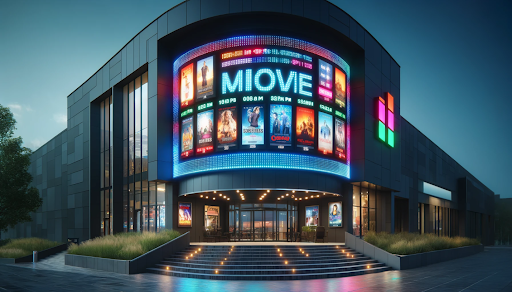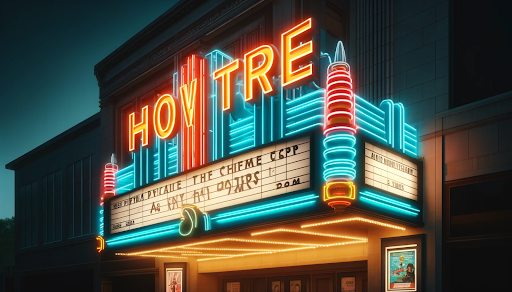To sign up for our daily email newsletter, CLICK HERE
Neon signs have been a quintessential part of movie theatre culture for decades. Their vibrant glow and eye-catching designs not only add to the aesthetic appeal of theatres but also serve as effective tools for marketing and branding. This article explores the history of custom neon signs in movie theatres, their rise in popularity, and why they continue to be a beloved feature in the cinematic world.
The Origins of Neon Signs
The story of neon signs begins in the early 20th century with the discovery of neon gas and its luminescent properties. French engineer and inventor Georges Claude is credited with creating the first neon lamp in 1910. By passing an electric current through neon gas, Claude was able to produce a bright, glowing light that could be used in signs.
Early Adoption in Advertising
The first commercial neon sign was displayed in 1912 at a barbershop in Paris. Its success quickly caught the attention of advertisers worldwide. By the 1920s, neon signs had made their way to the United States, where they were used to illuminate storefronts and attract customers. The unique ability of neon signs to stand out in the dark made them particularly appealing for businesses that operated at night, including movie theatres.
Neon Signs in Movie Theatres
Movie theatres were among the earliest adopters of neon signage in the United States. The Golden Age of Hollywood, spanning from the late 1920s to the early 1960s, saw a boom in the construction of grand theatres, often adorned with elaborate neon signs.

Art Deco Influence
During the 1930s and 1940s, the Art Deco movement significantly influenced the design of movie theatres and their signage. Neon signs, with their sleek lines and vibrant colors, complemented the bold geometric shapes and lavish decor typical of Art Deco architecture. These signs often featured the theatre’s name, film titles, and showtimes, creating an alluring display that attracted moviegoers from blocks away.
The Drive-In Era
The 1950s introduced the era of drive-in theatres, which became a staple of American culture. Neon signs played a crucial role in the identity of these outdoor cinemas, guiding patrons to the entrance and adding to the nostalgic charm of the drive-in experience. The bright, colorful lights were not only functional but also contributed to the overall ambiance, making the theatre more inviting and exciting.
The Popularity of Neon Signs
Neon signs have maintained their popularity over the decades for several reasons. Their unique aesthetic appeal, versatility, and ability to draw attention make them an enduring choice for movie theatres.
Aesthetic Appeal
The warm, glowing light of neon signs creates a nostalgic and enchanting atmosphere that is hard to replicate with other types of lighting. Neon signs evoke a sense of nostalgia, reminding people of the glamour and excitement of classic cinema. This aesthetic appeal is one of the key reasons why many modern theatres continue to use neon signage.
Versatility and Customization
Neon signs are highly versatile and can be customized to fit any design or branding requirements. They can be crafted into various shapes, sizes, and colors, making them suitable for a wide range of applications. Whether it’s a simple marquee sign or an intricate piece of art, neon signs can be tailored to meet the specific needs of a theatre.
Effective Advertising Tool
Neon signs are also incredibly effective as advertising tools. Their bright, eye-catching glow is visible from a distance, making it easy for potential patrons to spot the theatre. Additionally, neon signs can display important information such as movie titles, showtimes, and special events, helping to attract more visitors.
Comparison of Neon Signs with Other Signage
Here is a comparison of neon signs with other common types of signage used in movie theatres:
| Type of Signage |
Visibility |
Customization |
Energy Efficiency |
Cost |
Durability |
| Neon Signs |
High, visible at night |
High, customizable |
Moderate |
Moderate |
Long-lasting |
| LED Signs |
Very High, bright |
Very High, programmable |
High |
High |
Very Long-lasting |
| Traditional Bulbs |
Moderate |
Low |
Low |
Low |
Short-lived |
| Digital Displays |
High, versatile |
Very High, dynamic |
High |
Very High |
Variable |
The Future of Neon Signs in Movie Theatres
While modern technology has introduced new forms of signage, such as LED and digital displays, neon signs continue to hold a special place in the movie theatre industry. Many theatres choose to incorporate neon elements into their signage to maintain a connection to the past and preserve the nostalgic charm that neon lights bring.

Modern Innovations
Today’s neon signs benefit from advancements in technology that make them more energy-efficient and durable. LED neon, for instance, mimics the look of traditional neon but uses less energy and offers greater flexibility in design. These innovations ensure that neon signs remain relevant and practical for contemporary use.
Preserving Tradition
For many theatre owners and patrons, neon signs represent a cherished tradition that connects them to the golden age of cinema. By preserving and restoring vintage neon signs or creating new ones inspired by classic designs, theatres can honor this legacy while still appealing to modern audiences.
Conclusion
Custom neon signs have played a significant role in the history and identity of movie theatres. Their unique aesthetic appeal, versatility, and effectiveness as advertising tools have made them a beloved feature in the cinematic world. As theatres continue to evolve, neon signs will likely remain an integral part of their charm and character, bridging the gap between the nostalgic past and the innovative future. Whether through traditional neon or modern LED alternatives, the glowing lights of neon signs will continue to enchant moviegoers for generations to come.